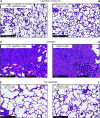Addition of 5% CO2 to Inspiratory Gas Prevents Lung Injury in an Experimental Model of Pulmonary Artery Ligation
- PMID: 34252009
- PMCID: PMC8534619
- DOI: 10.1164/rccm.202101-0122OC
Addition of 5% CO2 to Inspiratory Gas Prevents Lung Injury in an Experimental Model of Pulmonary Artery Ligation
Abstract
Rationale: Unilateral ligation of the pulmonary artery may induce lung injury through multiple mechanisms, which might be dampened by inhaled CO2. Objectives: This study aims to characterize bilateral lung injury owing to unilateral ligation of the pulmonary artery in healthy swine undergoing controlled mechanical ventilation and its prevention by 5% CO2 inhalation and to investigate relevant pathophysiological mechanisms. Methods: Sixteen healthy pigs were allocated to surgical ligation of the left pulmonary artery (ligation group), seven to surgical ligation of the left pulmonary artery and inhalation of 5% CO2 (ligation + FiCO2 5%), and six to no intervention (no ligation). Then, all animals received mechanical ventilation with Vt 10 ml/kg, positive end-expiratory pressure 5 cm H2O, respiratory rate 25 breaths/min, and FiO2 50% (±FiCO2 5%) for 48 hours or until development of severe lung injury. Measurements and Main Results: Histological, physiological, and quantitative computed tomography scan data were compared between groups to characterize lung injury. Electrical impedance tomography and immunohistochemistry analysis were performed in a subset of animals to explore mechanisms of injury. Animals from the ligation group developed bilateral lung injury as assessed by significantly higher histological score, larger increase in lung weight, poorer oxygenation, and worse respiratory mechanics compared with the ligation + FiCO2 5% group. In the ligation group, the right lung received a larger fraction of Vt and inflammation was more represented, whereas CO2 dampened both processes. Conclusions: Mechanical ventilation induces bilateral lung injury within 48 hours in healthy pigs undergoing left pulmonary artery ligation. Inhalation of 5% CO2 prevents injury, likely through decreased stress to the right lung and antiinflammatory effects.
Keywords: CO2 inhalation; VILI; pulmonary perfusion; therapeutic hypercapnia.
Figures






Comment in
-
Inhaled CO2 to Reduce Lung Ischemia and Reperfusion Injuries: Moving toward Clinical Translation?Am J Respir Crit Care Med. 2021 Oct 15;204(8):878-879. doi: 10.1164/rccm.202107-1665ED. Am J Respir Crit Care Med. 2021. PMID: 34375575 Free PMC article. No abstract available.
-
Addition of 5% CO2 to Inspiratory Gas in Preventing Lung Injury Due to Pulmonary Artery Ligation.Am J Respir Crit Care Med. 2022 Mar 1;205(5):586-587. doi: 10.1164/rccm.202110-2425LE. Am J Respir Crit Care Med. 2022. PMID: 34890528 Free PMC article. No abstract available.
-
Reply to Jha: Addition of 5% CO2 to Inspiratory Gas in Preventing Lung Injury Due to Pulmonary Artery Ligation.Am J Respir Crit Care Med. 2022 Mar 1;205(5):587-588. doi: 10.1164/rccm.202111-2500LE. Am J Respir Crit Care Med. 2022. PMID: 34890535 Free PMC article. No abstract available.
References
-
- Edmunds LH, Jr, Holm JC. Effect of inhaled CO2 on hemorrhagic consolidation due to unilateral pulmonary arterial ligation. J Appl Physiol. 1969;26:710–715. - PubMed
-
- Kolobow T, Spragg RG, Pierce JE. Massive pulmonary infarction during total cardiopulmonary bypass in unanesthetized spontaneously breathing lambs. Int J Artif Organs. 1981;4:76–81. - PubMed
-
- Greene R, Zapol WM, Snider MT, Reid L, Snow R, O’Connell RS, et al. Early bedside detection of pulmonary vascular occlusion during acute respiratory failure. Am Rev Respir Dis. 1981;124:593–601. - PubMed
-
- Nuckton TJ, Alonso JA, Kallet RH, Daniel BM, Pittet JF, Eisner MD, et al. Pulmonary dead-space fraction as a risk factor for death in the acute respiratory distress syndrome. N Engl J Med. 2002;346:1281–1286. - PubMed

